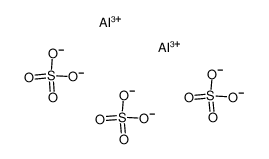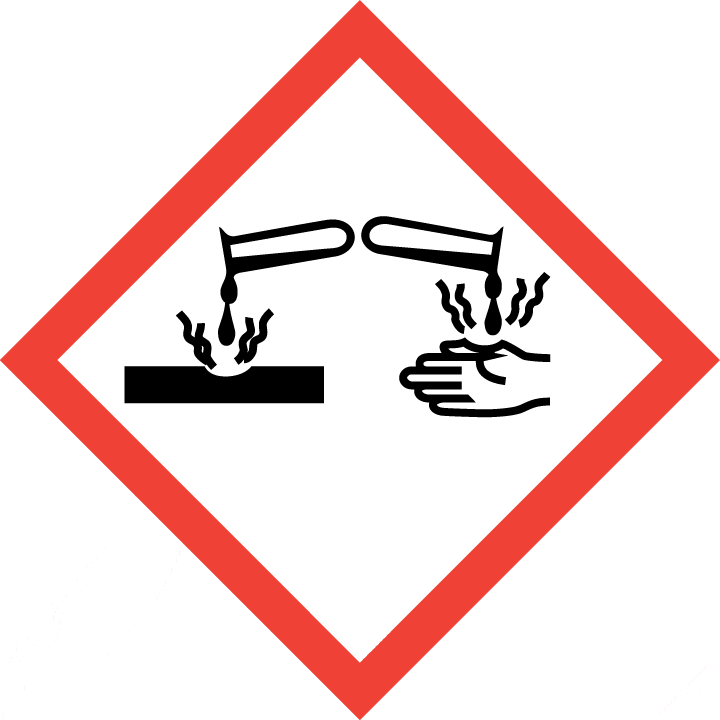| Product name | aluminium sulfate (anhydrous) |
|---|
| Product number | - |
|---|---|
| Other names | Aluminium sulfate |
| Identified uses | For industry use only. Food additives |
|---|---|
| Uses advised against | no data available |
| Company | MOLBASE (Shanghai) Biotechnology Co., Ltd. |
|---|---|
| Address | Floor 4 & 5, Building 12, No. 1001 North Qinzhou Road, Xuhui District, Shanghai, China |
| Telephone | +86(21)64956998 |
| Fax | +86(21)54365166 |
| Emergency phone number | +86-400-6021-666 |
|---|---|
| Service hours | Monday to Friday, 9am-5pm (Standard time zone: UTC/GMT +8 hours). |
Corrosive to metals, Category 1
Serious eye damage, Category 1
2.2 GHS label elements, including precautionary statements| Pictogram(s) |  |
|---|---|
| Signal word | Danger |
| Hazard statement(s) | H290 May be corrosive to metals H318 Causes serious eye damage |
| Precautionary statement(s) | |
| Prevention | P234 Keep only in original packaging. P280 Wear protective gloves/protective clothing/eye protection/face protection. |
| Response | P390 Absorb spillage to prevent material damage. P305+P351+P338 IF IN EYES: Rinse cautiously with water for several minutes. Remove contact lenses, if present and easy to do. Continue rinsing. P310 Immediately call a POISON CENTER/doctor/… |
| Storage | P406 Store in a corrosion resistant/...container with a resistant inner liner. |
| Disposal | none |
none
3.Composition/information on ingredients 3.1 Substances| Chemical name | Common names and synonyms | CAS number | EC number | Concentration |
|---|---|---|---|---|
| aluminium sulfate (anhydrous) | aluminium sulfate (anhydrous) | 10043-01-3 | none | 100% |
Consult a physician. Show this safety data sheet to the doctor in attendance.
If inhaledFresh air, rest. Refer for medical attention.
In case of skin contactRinse skin with plenty of water or shower.
In case of eye contactRinse with plenty of water for several minutes (remove contact lenses if easily possible). Refer immediately for medical attention.
If swallowedRinse mouth. Do NOT induce vomiting. Give one or two glasses of water to drink. Refer for medical attention .
4.2 Most important symptoms/effects, acute and delayedInhalation of dust irritates nose and mouth. Ingestion of large doses causes gastric irritation, nausea, vomiting, and purging. Dust irritates eyes and skin. (USCG, 1999)
Vapor irritates eyes, nose and respiratory tract due to formation of sulfuric acid. Ingestion of large doses causes gastric irritation, nausea, vomiting, and purging. Liquid irritates eyes and skin. (USCG, 1999)
4.3 Indication of immediate medical attention and special treatment needed, if necessary/Exposure to aluminum sulfate/: Call for medical aid. Dust: Irritating to eyes, nose and throat. If inhaled will cause difficult breathing. If in eyes, hold eyelids open and flush with plenty of water. If breathing has stopped, give artificial respiration. If breathing is difficult, give oxygen. Solid: Irritating to skin and eyes. If swallowed with cause nausea or vomiting. Remove contaminated clothing and shoes. Flush affected areas with plenty of water. If in eyes, hold eyelids open and flush with plenty of water. If swallowed and victim is conscious, have victim drink water or milk. If swallowed and victim is unconscius or having convulsions, do nothing except keep victim warm.
5.Fire-fighting measures 5.1 Extinguishing media Suitable extinguishing mediaIf material involved in fire: Extinguish fire using agent suitable for type of surrounding fire. (Material itself does not burn or burns with difficulty.)
5.2 Specific hazards arising from the chemicalSpecial Hazards of Combustion Products: Produces sulfuric acid upon decomposition. (USCG, 1999)
5.3 Special protective actions for fire-fightersWear self-contained breathing apparatus for firefighting if necessary.
6.Accidental release measures 6.1 Personal precautions, protective equipment and emergency proceduresUse personal protective equipment. Avoid dust formation. Avoid breathing vapours, mist or gas. Ensure adequate ventilation. Evacuate personnel to safe areas. Avoid breathing dust. For personal protection see section 8.
6.2 Environmental precautionsPersonal protection: particulate filter respirator adapted to the airborne concentration of the substance. Do NOT let this chemical enter the environment. Sweep spilled substance into covered plastic containers. If appropriate, moisten first to prevent dusting. Store and dispose of according to local regulations.
6.3 Methods and materials for containment and cleaning upEnvironmental considerations: Land spill: Dig a pit, pond, lagoon, holding area to contain liquid or solid material. /SRP: If time permits, pits, ponds, lagoons, soak holes, or holding areas should be sealed with an impermeable flexible membrane liner./ Cover solids with a plastic sheet to prevent dissolving in rain or fire fighting water.
7.Handling and storage 7.1 Precautions for safe handlingAvoid contact with skin and eyes. Avoid formation of dust and aerosols. Avoid exposure - obtain special instructions before use.Provide appropriate exhaust ventilation at places where dust is formed. For precautions see section 2.2.
7.2 Conditions for safe storage, including any incompatibilitiesSeparated from bases and strong oxidants. Dry. Store in an area without drain or sewer access. Provision to contain effluent from fire extinguishing.Ambient /Octadecohydrate/
8.Exposure controls/personal protection 8.1 Control parameters Occupational Exposure limit valuesRecommended Exposure Limit: 10-Hr Time-Weighted Avg: 10 mg/cu m (total). /Aluminum/
Recommended Exposure Limit: 10 Hr Time-Weighted Avg: 5 mg/cu m (resp). /Aluminum/
Recommended Exposure Limit: 10 Hr Time-Weighted Avg: 2 mg/cu m. /Aluminum (soluble salts and alkyls, as Al)/
Recommended Exposure Limit: 10 Hr Time-Weighted Avg: 5 mg/cu m. /Aluminum (pyro powders and welding fumes, as Al)/
Biological limit valuesno data available
8.2 Appropriate engineering controlsHandle in accordance with good industrial hygiene and safety practice. Wash hands before breaks and at the end of workday.
8.3 Individual protection measures, such as personal protective equipment (PPE) Eye/face protectionSafety glasses with side-shields conforming to EN166. Use equipment for eye protection tested and approved under appropriate government standards such as NIOSH (US) or EN 166(EU).
Skin protectionWear impervious clothing. The type of protective equipment must be selected according to the concentration and amount of the dangerous substance at the specific workplace. Handle with gloves. Gloves must be inspected prior to use. Use proper glove removal technique(without touching glove's outer surface) to avoid skin contact with this product. Dispose of contaminated gloves after use in accordance with applicable laws and good laboratory practices. Wash and dry hands. The selected protective gloves have to satisfy the specifications of EU Directive 89/686/EEC and the standard EN 374 derived from it.
Respiratory protectionWear dust mask when handling large quantities.
Thermal hazardsno data available
9.Physical and chemical properties| Physical state | White powder |
|---|---|
| Colour | White, lustrous crystals, pieces, granules, or powder |
| Odour | ODORLESS |
| Melting point/ freezing point | 770ºC |
| Boiling point or initial boiling point and boiling range | 330ºC at 760 mmHg |
| Flammability | Not combustible. Gives off irritating or toxic fumes (or gases) in a fire. |
| Lower and upper explosion limit / flammability limit | no data available |
| Flash point | no data available |
| Auto-ignition temperature | no data available |
| Decomposition temperature | 770°C |
| pH | 2,9 or above (5 % solution) |
| Kinematic viscosity | no data available |
| Solubility | In water:soluble |
| Partition coefficient n-octanol/water (log value) | no data available |
| Vapour pressure | Esentially zero. |
| Density and/or relative density | 2.71 |
| Relative vapour density | no data available |
| Particle characteristics | no data available |
no data available
10.2 Chemical stabilityStable in air.
10.3 Possibility of hazardous reactionsMay burn, but will not ignite.Aqueous solutions of ALUMINUM SULFATE are acidic. The solid may corrode metals in presence of moisture.
10.4 Conditions to avoidno data available
10.5 Incompatible materialsMay corrode metals in presence of moisture. /Aluminum sulfate octadecahydrate/
10.6 Hazardous decomposition productsWhen heated to decomposition it emits toxic fumes of /sulfur oxides/.
11.Toxicological information Acute toxicity- Oral: LD50 Rat oral 1930 mg/kg
- Inhalation: no data available
- Dermal: no data available
no data available
Serious eye damage/irritationno data available
Respiratory or skin sensitizationno data available
Germ cell mutagenicityno data available
CarcinogenicityA4: Not classifiable as a human carcinogen. /Aluminum metal and insoluble compounds/
Reproductive toxicityno data available
STOT-single exposureno data available
STOT-repeated exposureno data available
Aspiration hazardno data available
12.Ecological information 12.1 Toxicity- Toxicity to fish: LC50 Oncorhynchus mykiss (Rainbow trout) 91 ug/L/144 hr; renewal (soft, acidic water) /technical product
- Toxicity to daphnia and other aquatic invertebrates: no data available
- Toxicity to algae: no data available
- Toxicity to microorganisms: no data available
no data available
12.3 Bioaccumulative potentialno data available
12.4 Mobility in soilno data available
12.5 Other adverse effectsno data available
13.Disposal considerations 13.1 Disposal methods ProductThe material can be disposed of by removal to a licensed chemical destruction plant or by controlled incineration with flue gas scrubbing. Do not contaminate water, foodstuffs, feed or seed by storage or disposal. Do not discharge to sewer systems.
Contaminated packagingContainers can be triply rinsed (or equivalent) and offered for recycling or reconditioning. Alternatively, the packaging can be punctured to make it unusable for other purposes and then be disposed of in a sanitary landfill. Controlled incineration with flue gas scrubbing is possible for combustible packaging materials.
14.Transport information 14.1 UN Number| ADR/RID: UN1760 | IMDG: UN1760 | IATA: UN1760 |
| ADR/RID: CORROSIVE LIQUID, N.O.S. |
| IMDG: CORROSIVE LIQUID, N.O.S. |
| IATA: CORROSIVE LIQUID, N.O.S. |
| ADR/RID: 9.2 | IMDG: 9.2 | IATA: 9.2 |
| ADR/RID: unknown | IMDG: unknown | IATA: unknown |
| ADR/RID: no | IMDG: no | IATA: no |
no data available
14.7 Transport in bulk according to Annex II of MARPOL 73/78 and the IBC Codeno data available
15.Regulatory information 15.1 Safety, health and environmental regulations specific for the product in question| Chemical name | Common names and synonyms | CAS number | EC number |
|---|---|---|---|
| aluminium sulfate (anhydrous) | aluminium sulfate (anhydrous) | 10043-01-3 | none |
| European Inventory of Existing Commercial Chemical Substances (EINECS) | Listed. | ||
| EC Inventory | Listed. | ||
| United States Toxic Substances Control Act (TSCA) Inventory | Listed. | ||
| China Catalog of Hazardous chemicals 2015 | Not Listed. | ||
| New Zealand Inventory of Chemicals (NZIoC) | Listed. | ||
| Philippines Inventory of Chemicals and Chemical Substances (PICCS) | Listed. | ||
| Vietnam National Chemical Inventory | Listed. | ||
| Chinese Chemical Inventory of Existing Chemical Substances (China IECSC) | Listed. | ||
| Creation Date | Aug 13, 2017 |
|---|---|
| Revision Date | Aug 13, 2017 |
- CAS: Chemical Abstracts Service
- ADR: European Agreement concerning the International Carriage of Dangerous Goods by Road
- RID: Regulation concerning the International Carriage of Dangerous Goods by Rail
- IMDG: International Maritime Dangerous Goods
- IATA: International Air Transportation Association
- TWA: Time Weighted Average
- STEL: Short term exposure limit
- LC50: Lethal Concentration 50%
- LD50: Lethal Dose 50%
- EC50: Effective Concentration 50%
- IPCS - The International Chemical Safety Cards (ICSC), website: http://www.ilo.org/dyn/icsc/showcard.home
- HSDB - Hazardous Substances Data Bank, website: https://toxnet.nlm.nih.gov/newtoxnet/hsdb.htm
- IARC - International Agency for Research on Cancer, website: http://www.iarc.fr/
- eChemPortal - The Global Portal to Information on Chemical Substances by OECD, website: http://www.echemportal.org/echemportal/index?pageID=0&request_locale=en
- CAMEO Chemicals, website: http://cameochemicals.noaa.gov/search/simple
- ChemIDplus, website: http://chem.sis.nlm.nih.gov/chemidplus/chemidlite.jsp
- ERG - Emergency Response Guidebook by U.S. Department of Transportation, website: http://www.phmsa.dot.gov/hazmat/library/erg
- Germany GESTIS-database on hazard substance, website: http://www.dguv.de/ifa/gestis/gestis-stoffdatenbank/index-2.jsp
- ECHA - European Chemicals Agency, website: https://echa.europa.eu/




















